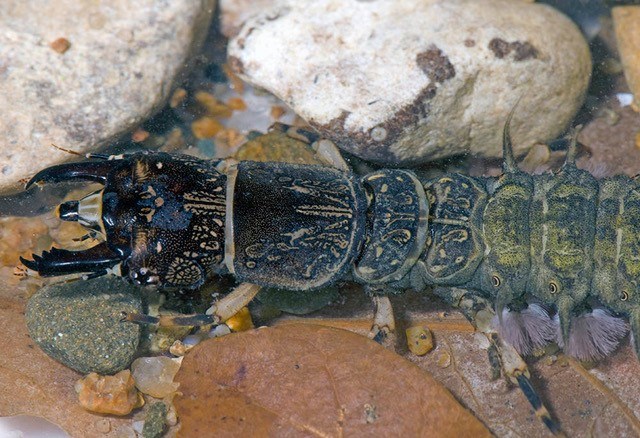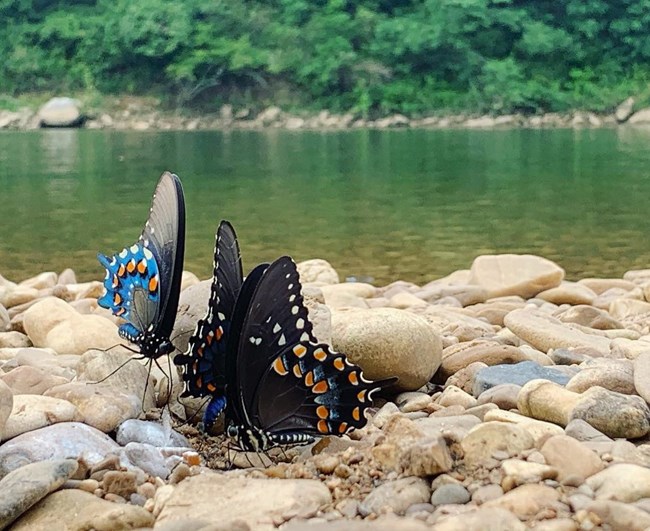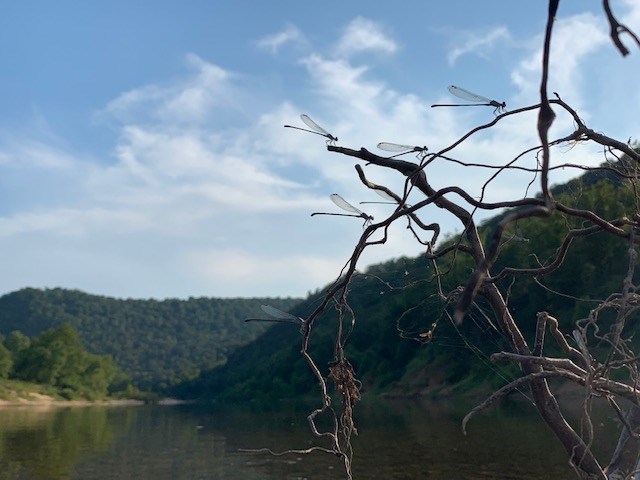
Dr. Greg Courtney Aquatic Aquatic macroinvertebrates are small organisms that can be seen with the unaided eye. They have hard outer shells (exoskeletons) rather than internal skeletons, and no backbone. Aquatic macroinvertebrates are the most abundant organisms within a stream, and they are an integral part of the river system’s food chain. They can usually be found on the bottom of the stream, in the soft substrate or attached to pebbles and larger rocks. The Buffalo National River has over 128 species of macroinvertebrates; most are from the orders of Mayflies, Caddisflies, Stoneflies, and True flies- or Midges. The abundance of these organisms in the Buffalo River and its tributaries tells us a lot about the health of the ecosystem, but the diversity of the aquatic macroinvertebrates themselves also proves very helpful. Many species serve as “indicators,” meaning their presence (or absence) can show a change in water quality in that specific reach of habitat. Scientists can classify macroinvertebrates into four different groups: very intolerant of pollution, moderately intolerant of pollution, fairly tolerant of pollution, and very tolerant of pollution. If many members of a group that is fairly tolerant of pollution are present in a community, it can indicate degradation of some sort. Diversity and species richness should be high within the Buffalo River, but research and field observation indicates that the diversity and richness of these communities are declining in certain reaches of the river. Changes in land use, declines in the quality of water from tributaries, introduced non-native species, and degradation of physical habitat are some of the factors causing this decline. Current efforts by the Park to protect these resources include the development of an inventory and monitoring project that examines the macroinvertebrate communities over the long-term in conjunction with water-quality collections. 
NPS Photo/S. McLear Butterflies As of 2012, there were 111 identified species of butterflies and skippers in the Park and its vicinity. They can be seen in woodlands, near streams, in glades and old fields, even along roadsides. When looking for butterflies and skippers, you might find species frequenting flowers, trees with flowing sap, or even feeding on rotting fruit on the ground! Other species are attracted to moist soils- sometimes multiple species will be seen in one small area having a “puddle party,” taking in nutrients from the wet ground. Butterflies and skippers are very similar and they both fly during the day. The quickest way to tell them apart is by their antennae; true butterflies have clubbed antennae while skippers have antennae that taper into a hook. Skippers also typically fly much faster and erratically. There can be considerable variation between butterflies of the same species, including differences in size, color, markings, and even condition of the wings. Their wings get their brilliant color from thousands of microscopic scales, but they can be easily brushed off if disturbed. Some species closely resemble one another, which makes identification difficult. This is a defense adaptation known as mimicry, and is used by some species to fool predators who might mistake them as poisonous if eaten. A common occurrence of mimicry in the Park is the Spicebush Swallowtail, whose upper wings mimic the Pipevine Swallowtail, but the underside markings look much different. Moths Belonging to the same order as butterflies and skippers, moths are most often found flying at dusk and through the night, although some fly during the day. Males have very long antenna, while females’ are shorter. Antenna can be either pointed or fern-like, but all have some sort of feathered or saw-edged appearance. Their front and back wings are usually joined together, as compared to butterflies and skippers who typically have separated wings. Entomologists, or scientists who study insects, sometimes use a method of study known as night collection, where they set up a system of lights and cloth resembling bed sheets in order to trap a wide variety of moths. In doing so, they can get a better idea of what species are present and in what amounts, which can tell them even more about the ecosystem. The specimens collected are identified and either released or kept for display. 
NPS Photo/S. McLear Dragonflies and Damselflies Belonging to the order Odonata, these insects are some of the most primitive, showing up in the fossil record 250 million years ago. The Buffalo River is habitat to a wide range of dragonfly and damselfly species. They often move quickly, darting from plants to the opposite bank of the river in the blink of an eye, but many common species are easily identified. Unlike other insects, neither dragonflies or damselflies have well-developed antennae or tympanic membranes, parts of the body that allow them to “hear” by sensing vibration. Instead, they have complex eyes. Dragonflies can be recognized by their large, compound eyes that often touch and make up the bulk of their head, while Damselflies have smaller eyes that are spaced much further apart. Furthermore, dragonflies have two sets of wings that are different sizes while damselflies have two sets that are the same size. Diverse coloring and markings on the wings such as bands, spangles, or saddlebags, give these insects their distinctive names. These “living fossils” can be found flying during from dawn to dusk, in woodland areas, grasslands and fields, and especially near bodies of water. Dragonfly and damselfly larvae, or nymphs, are commonly found living in ponds and streams. As adults, dragonflies and damselflies are active predators, feeding on all sorts of bugs by trapping them with their hairy legs and using their strong jaws to chomp down on prey head-first.
Terrestrial Numerous species exist throughout these forests. One species of interest is the Red Oak Borer Beetle. Red Oak Borer Beetle may infest large tracts of Red Oaks that are located on top of the dry ridge tops. These beetles are native to the Ozarks, but numerous environmental factors still under study have combined to produce large and troublesome densities of these beetles. Prescribed fire is one of the strategies being used to reduce certain life cycle habitat niches of the beetle. Surprisingly, certain woodpeckers are also a natural controlling agent; in some cases they are able to eat up to 40% of larvae before they do significant damage. Numerous research projects are looking into the infestation problem, and hopefully clear management strategies will emerge to deal with this environmental dilemma. |
Last updated: August 13, 2021
